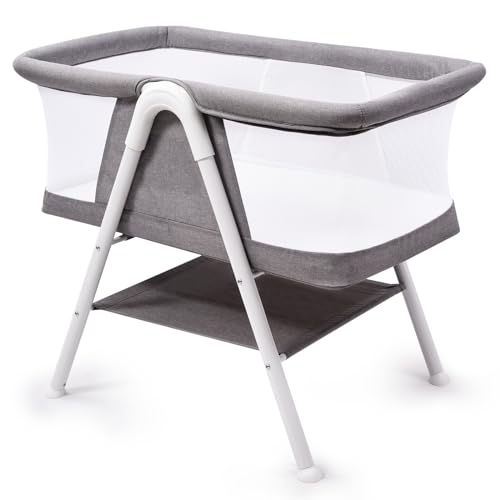The Advanced Guide To Bedside Cot For Close Bonding
Bedside Cot for Close Bonding: Enhancing Parent-Child Connection
Intro
The arrival of a newborn is a memorable event that's accompanied by a wealth of joyous feelings and newly found obligations. As parents navigate the myriad of choices they face, one crucial consideration is where their baby will sleep throughout those early months. A bedside cot, likewise called a co-sleeper, has actually emerged as a significantly popular choice among caretakers looking for to promote close bonding with their infants while guaranteeing safe sleep practices. This short article checks out the advantages of utilizing a bedside cot, its effect on bonding, safe sleeping practices, and essential considerations for parents or guardians.
- * *
What is a Bedside Cot?
A bedside cot is a type of crib that is firmly connected to the side of the adult bed, enabling parents to have their newborn close at hand during the night. This setup allows for easy availability without having to get out of bed, hence improving nighttime feeding and soothing experiences.
Types of Bedside Cots
Connected Co-Sleepers: These designs connect straight to the parent's bed and provide a safe and secure sleeping environment for the infant while preserving easy access for feeding and comfort.
Freestanding Bedside Cots: Operated as a different unit however put nearby to the bed, these cots provide specific sleeping areas while still permitting closeness.
Convertible Bedside Cots: These versatile models can adjust as the kid grows, transforming from a cot to a toddler bed or play location, extending their usability.
- * *
Advantages of a Bedside Cot for Close Bonding
The use of a bedside cot not just assures convenience but also nurtures a special bond in between parents and their kids. Here are some essential advantages:
Facilitates Immediate Response: Proximity permits caretakers to react promptly to the baby's needs, whether for feeding, calming, or convenience, consequently establishing security and trust.
Promotes Breastfeeding: Nighttime breastfeeding becomes simpler when the baby is within reach, helping with a more natural feeding regimen.
Reinforces Emotional Connection: Close physical presence can boost the psychological bond through skin-to-skin contact and mother-infant interactions during nighttime awakenings.
Encourages Sleep Synchronization: Being near each other can help control the infant's sleep patterns to carefully align with those of the parents.
Lessens Sleep Disruption: With the baby nearby, parents might sleep much better, knowing they do not have to leave their bedside to participate in to their baby.
Table 1: Benefits of Using a Bedside Cot
Benefit
Description
Immediate Response
Quick access to the baby for feeding or comforting.
Promotes Breastfeeding
Much easier to breastfeed in the evening due to proximity.
Reinforces Emotional Connect
Fosters emotional bonds through regular contact.
Encourages Sleep Synchronization
Assists both parent and baby to establish synchronized sleep patterns.
Decreases Sleep Disruption
Decreases nighttime awakenings for parents.
- * *
Safe Sleep Practices
While bedside cots supply numerous benefits, parents should ensure the baby's sleep environment abides by safety protocols. Here are some essential security tips:
- Firm Mattress: Ensure the cot has a company bed mattress that fits comfortably to prevent any gaps where the baby could end up being trapped.
- Sids Prevention: Place the baby on their back to sleep, which satisfies the most crucial suggestion to avoid Sudden Infant Death Syndrome (SIDS).
- Keep Bedding Minimal: Use a fitted sheet and keep other bed linen to a minimum to avoid suffocation risks.
- Maintain Distance: Ensure the cot is safely connected to your bed, decreasing the danger of falls.
- Limitation Soft Objects: Keep soft toys, pillows, and blankets out of the cot to offer a safe sleeping environment.
Table 2: Safe Sleep Practices for Bedside Cots
Security Tip
Description
Firm Mattress
Use a firm bed mattress that fits comfortably into the cot.
SIDS Prevention
Constantly position the baby on their back to sleep.
Keep Bedding Minimal
Limit bed linen products to prevent suffocation dangers.
Maintain Distance
Guarantee the cot is securely protected to the adult bed.
Limit Soft Objects
Get rid of soft toys and pillows from the sleeping area.
- * *
Factors to consider Before Choosing a Bedside Cot
Selecting the best bedside cot needs deliberation and factor to consider of different factors:
- Size: Ensure the cot fits comfortably together with your bed without jeopardizing space.
- Reduce of Use: Look for models that are easy to use and basic to operate, particularly during nighttime feeding.
- Security Features: Safety straps and locking systems ought to remain in place to prevent accidental detachment.
- Product Safety: Choose non-toxic, baby-friendly products with compliant security standards.
Often Asked Questions (FAQs)
1. Is Infant Bedside Cot to use a bedside cot?Yes, bedside cots can be safe when properly connected to the adult bed and utilized according to safety guidelines.
2. At what Bedside Crib With Wheels can I transition my baby to their own room?Normally, health specialists recommend transitioning babies to their own room in between 6 months to 1 year, however every family scenario may vary.
3. How much space does a bedside cot need?Bedside cots vary in size; it's important to guarantee adequate space beside your bed for proper installation and access.
4. Can a bedside cot be used for overnight trips?Some models are portable and designed for travel, making them appropriate for overnight journeys or holidays.
5. How do I clean up a bedside cot?Describe the maker's guidelines for proper cleansing guidelines to maintain hygiene and security.
- * *
A bedside cot works as an important tool for fostering close bonding between parents and their infants. By making sure easy access during nighttime, promoting breastfeeding, and allowing instant responsiveness, a bedside cot improves the parent-child relationship during those essential early months. When combined with safe sleep practices, it supplies an environment that supports psychological development while prioritizing safety. For any new parent, buying a quality bedside cot can lead to a lovely co-sleeping experience loaded with bonding opportunities and peaceful nights.
